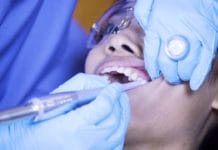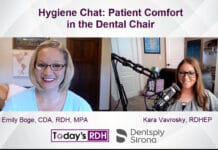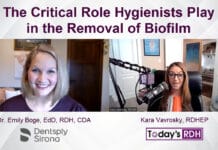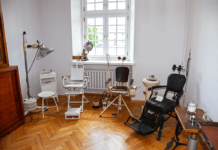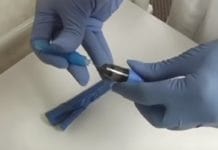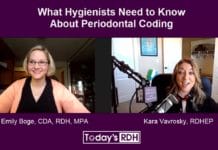How much do you know about face masks?
Disclosure: We value transparency at Today’s RDH. This quiz is sponsored content from Dentsply Sirona Preventive as part of our sponsored partner program.
The highest concentration of dental aerosols is found within 4 feet in front of a patient. Ninety-five percent of dental treatment generated aerosols are 5 Qm or less in diameter and contain multiple types of pathogenic bacteria and viruses.
“The highest concentration of dental aerosols is found within 2 feet in front of the patient, typically where a dental care provider is positioned. The extent of exposure to aerosolized particles during dental procedures can be extensive. In addition, as larger droplets evaporate, residual droplet nuclei, smaller than 10 microns (µm) in diameter, form and can remain airborne for extended periods in dental treatment areas. Ninety-five percent of dental treatment generated aerosols are 5 µm or less in diameter and contain multiple types of pathogenic bacteria and viruses.1”
1. Molinari, J.A., Nelson, P. (July, 2016). Face Masks: What to Wear and When. (Report No. 18) Ann Arbor, Michigan: The Dental Advisor.
Masks should be changed for each patient, after 1 hour during prolonged treatment, and every 20 minutes in a highly aerosolized environment.
“Mask use in health care was initially recommended for protection against bacteria and viruses, aerosolized during treatment. As further knowledge was obtained concerning respiratory infections and their control, the rationale for wearing masks was expanded to include protection against spatter particles, splashes, and aerosols. Masks that cover the nose and mouth can protect health professionals when used properly. Masks should be changed for each patient, after 1 hour during prolonged treatment, and every 20 minutes in a highly aerosolized environment.1”
1. Molinari, J.A., Nelson, P. (July, 2016). Face Masks: What to Wear and When. (Report No. 18) Ann Arbor, Michigan: The Dental Advisor.
For procedures where heavy to moderate levels of fluid, spatter, and/or aerosols are produced, such as when using an ultrasonic scaler, an _______ mask is appropriate.
The American Society of Testing and Materials (ASTM) specifies performance requirments for medical face masks based on testing for five criteria. These criteria include bacterial filtration efficiency, sub-micron particulate filtration efficiency, fluid resistance to penetration, differential pressure, and flammability.1
ASTM Mask Levels1
ASTM 1 (low barrier): For procedures where fluid, spatter, and/or aerosols are produced in low concentration. Examples include taking radiographs, fluoride treatments, patient exams, working in a lab, or disinfecting an operatory.
ASTM 2 (moderate barrier): For procedures where fluid, spatter, and/or aerosols are produced in moderate concentration. Examples include hand scaling during a dental prophylaxis, rubber cup polishing, or sealants.
ASTM 3 (high barrier): For procedures where heavy to moderate levels of fluid, spatter, and/or aerosols are produced. Examples include ultrasonic scaling or air polishing.
1. Molinari, J.A., Nelson, P. (July, 2016). Face Masks: What to Wear and When. (Report No. 18) Ann Arbor, Michigan: The Dental Advisor.
When donning a mask, the pleats on a mask should open upward for correct orientation.
Steps for donning a mask1:
1. Clean hands before touching mask.
2. Orient mask for proper placement.
a. Front vs. Back – side facing up in box is always the front of the mask.
b. Up vs. Down - pleats should open downward (i.e., “waterfall” effect).
c. Aluminum noseband is pre-bent to the contour of the nose to help with orientation.
3. Holding mask by ear loops, place loops around each ear.
4. Mold malleable strip at top edge of mask to shape of nose.
5. Pull bottom of mask over mouth and chin.
1. Molinari, J.A., Nelson, P. (July, 2016). Face Masks: What to Wear and When. (Report No. 18) Ann Arbor, Michigan: The Dental Advisor.
Factors to consider when selecting a face mask include which of the following?
Factors to consider when selecting face masks1:
1. Able to provide appropriate protection for airborne particles generated during the procedure.
2. Made of soft material that doesn’t irritate skin or induce an allergic reaction.
3. Comprised of material that does not collapse when worn or when wet.
4. Has a high bacterial filtration efficiency (BFE).
5. Easy to put on and remove.
6. Does not contact the wearer’s nostrils or lips.
7. Does not cause fogging of eyewear.
1. Molinari, J.A., Nelson, P. (July, 2016). Face Masks: What to Wear and When. (Report No. 18) Ann Arbor, Michigan: The Dental Advisor.






